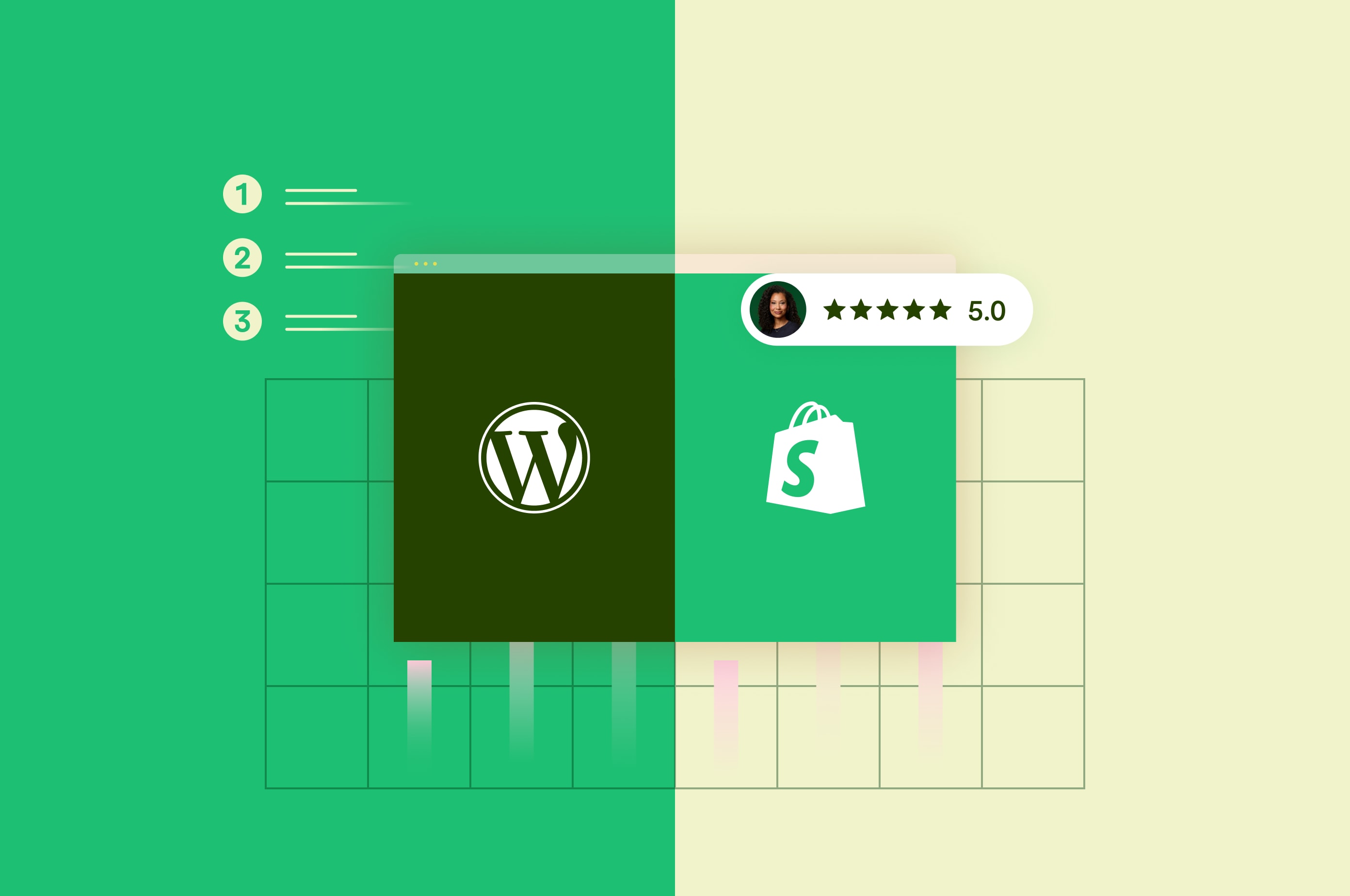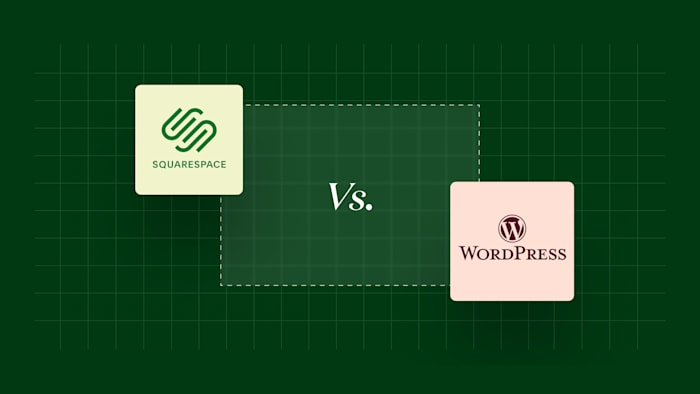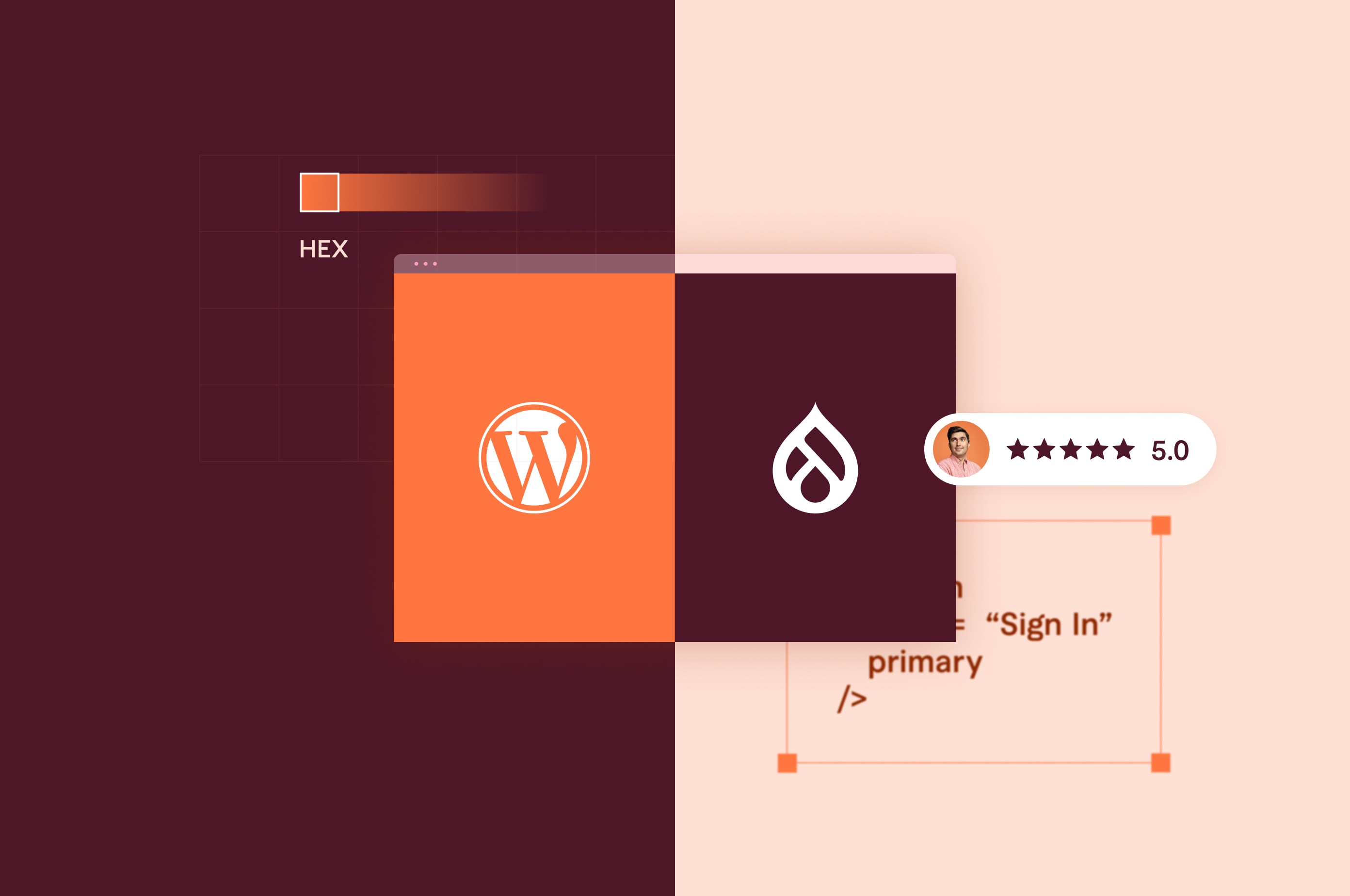Webflow vs. Squarespace: Which Platform Offers the Best Design Flexibility?
Webflow provides a visual coding experience that gives experienced developers design flexibility. Squarespace offers a user-friendly drag-and-drop experience for website design beginners.
 January 17, 2025
January 17, 2025 14 minute reading
14 minute reading
Webflow and Squarespace are two of the most popular website builders, but they provide very different experiences. In short, Webflow uses visual coding tools to support flexibility, while Squarespace uses prebuilt elements to simplify design.
But which website builder is better for your web development project, Webflow or Squarespace?
In this guide, we'll walk through a side-by-side comparison of Webflow vs. Squarespace website-building solutions. We'll cover everything, including pricing, user experience, SEO, support, ecommerce, and AI tools.
Differences between Webflow vs. Squarespace
Here are some of the main differences between the website builders Webflow and Squarespace if you’re looking to design a website.
1. Pricing
Here is a breakdown of Webflow and Squarespace pricing to help you get a better idea of what platform is best for your budget.
Webflow pricing
Webflow offers five different pricing tiers for users with different needs:
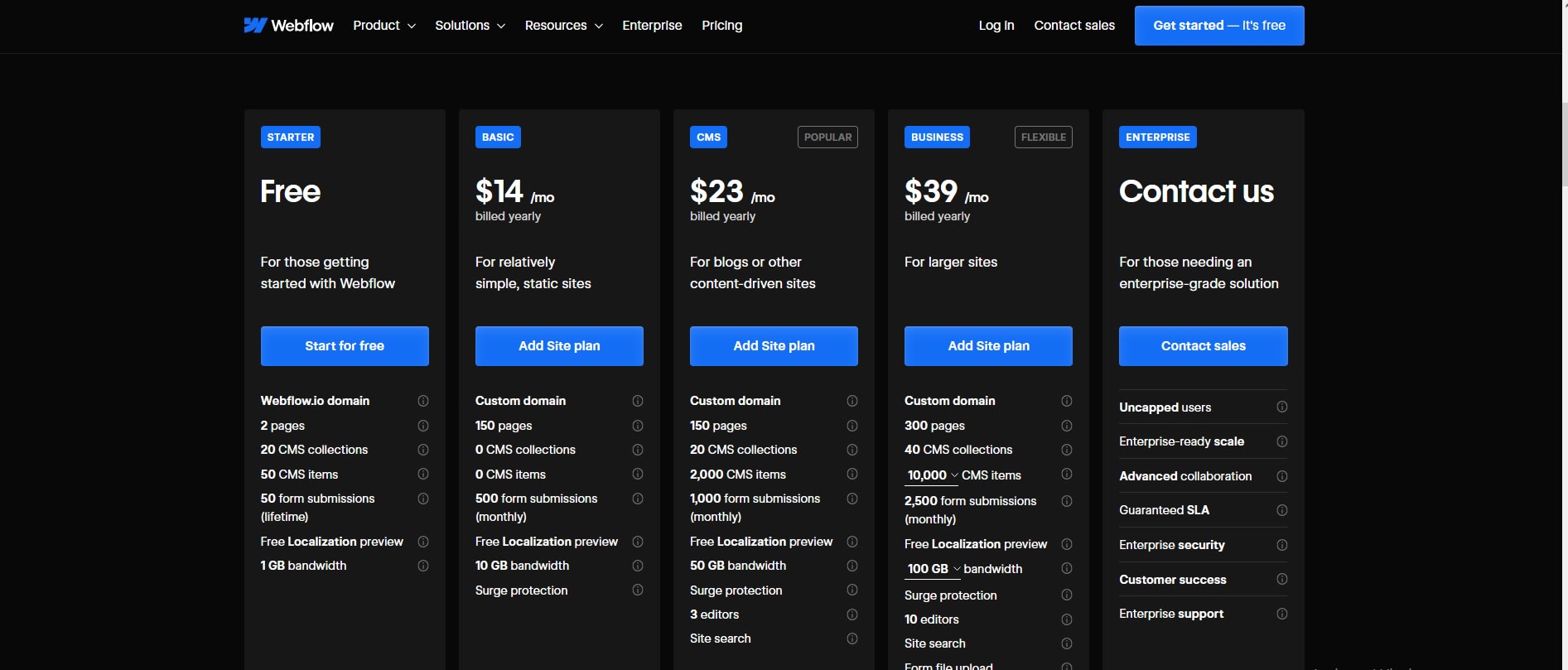
Webflow
Starter (designed for new users): Free for Webflow.io domain with two pages, 20 CMS collections, 50 CMS items, 50-lifetime form submissions, free localization previews, and 1 GB of bandwidth.
Basic (for simple static sites): $14 monthly billed annually for a custom domain with 150 pages, no CMS collections or items, 500 monthly form submissions, free localization previews, 10 GB of bandwidth, and surge protection.
CMS (for blogs and content sites): $23 a month billed annually, expands Basic plan to 20 CMS collections, 200 CMS items, 1,000 monthly form subscriptions, 50 GB of bandwidth, three editors, and site search
Business (for larger sites): $39 a month billed annually, expands CMS plan to 300 pages, 40 CMS collections, 10,000 CMS items, 2,500 monthly form subscriptions, 100 GB of bandwidth, 10 editors, and form file uploads
Enterprise (for corporate website design): Custom pricing for unlimited users, enterprise scale, collaboration features, service-level agreements, enterprise security, and dedicated customer success and support
Most small business users will pay between $14 and $39 a month with Webflow, depending on your site's size. This equates to $168 to $468 annually.
Squarespace pricing
Squarespace pricing features four tiers, with a free 14-day trial available:

Squarespace
Personal: $25 monthly (or $16 a month for annual billing), mobile-optimized site, templates, free invoicing
Business: $36 monthly ($23 a month annually), includes site analytics, support for selling products and processing checkouts, 3% per transaction fee for online sales (plus processing)
Basic Commerce: $40 monthly ($28 a month annually), includes merchandise marketing features, 0% transaction fee (plus processing)
Advanced Commerce: $72 monthly ($52 a month annually): includes advanced shipping, advanced discounts, subscription capability, 0% transaction fee (plus processing)
For all pricing plans, custom domains come with annual payments.
Most small business users will need a Business, Basic Commerce, or Advanced Commerce plan. Expect to pay $432 to $864 annually.
2. User-experience
Both Webflow and Squarespace promote positive user experience by providing assistance throughout the design process, but their experience feels different. Here’s a closer look:
Webflow user experience
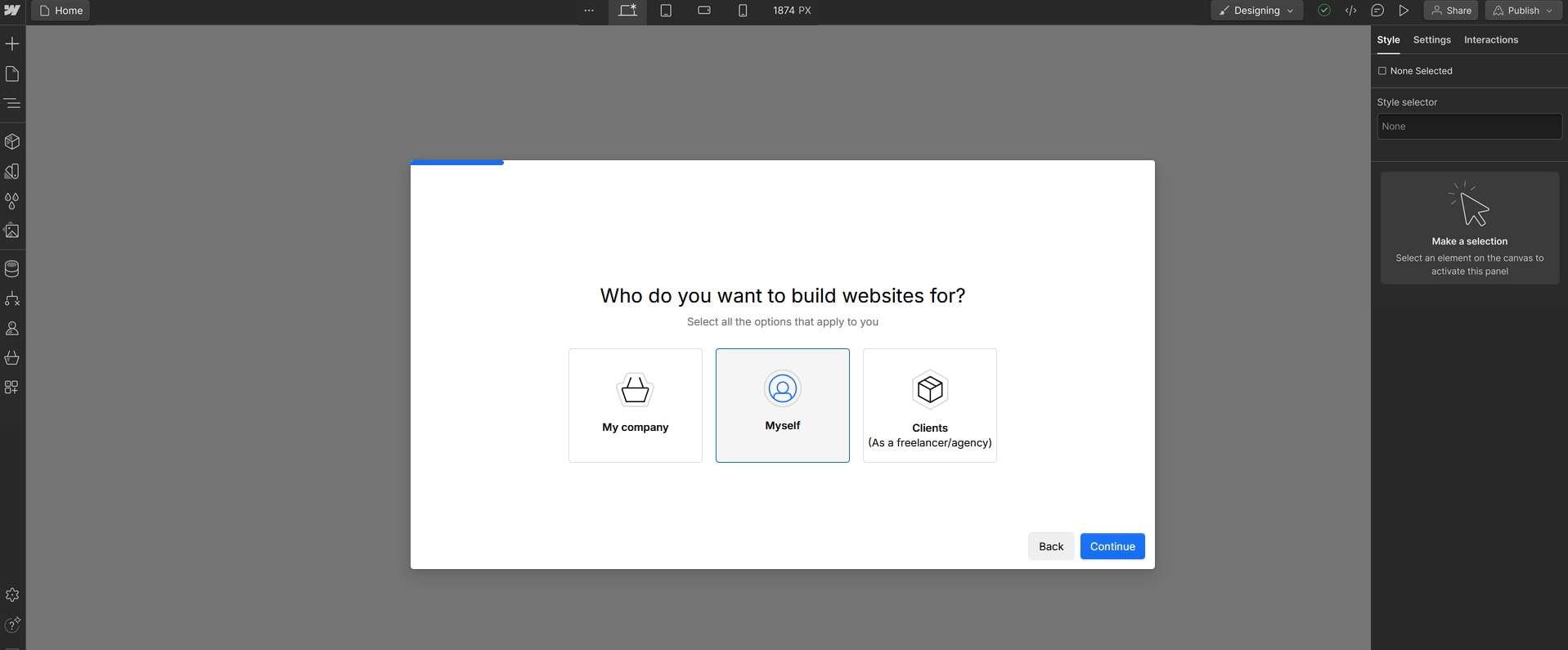
Webflow
Webflow supports user experience by providing the following:
Onboarding wizard: Helps you select your site's purpose, suggests template options, and offers development support.
Flexible building options: Allows you to build from a blank site, borrow a template, or start with a tutorial.
In-app site-building checklist: Guides you through choosing colors and fonts, editing images, and modifying layouts.
Workspace dashboard: Lets you manage your sites and settings efficiently.
Navigational menu: Provides access to your dashboard, settings, code search tools, and help features for each site.
Sidebar menu: Includes features for navigating content, site-building tools, and help resources.
Top menu: Offers device preview options, design and editing tools, and publishing features.
Access to tutorials and learning tools: Includes a sidebar for tutorials, a learning assistant, and a code search tool.
Audit tool: Tests site performance and usability to ensure quality.
Comprehensive help tools: Accessible from navigational menus, including a search bar, guides, courses, a community forum, and help request submission.
These features provide Webflow users with a strongly supported user experience guiding you through the web design process.
Squarespace user experience

Squarespace
Squarespace promotes user experience by providing:
Onboarding wizard: Walks you through selecting your site's topic, purpose, and template.
AI website builder: Assists in choosing your site's template with an AI-driven approach.
Administrative dashboard: Lists options to manage your site efficiently.
Setup guide link: Offers assistance with site structure, header design, branding, and SEO.
Help center access: Includes a dashboard link that opens Squarespace's help center in a separate window.
These features deliver Squarespace customers a user experience with strong support.
3. Features
Now, let’s take a look at the features of Webflow vs. Squarespace.
Webflow features
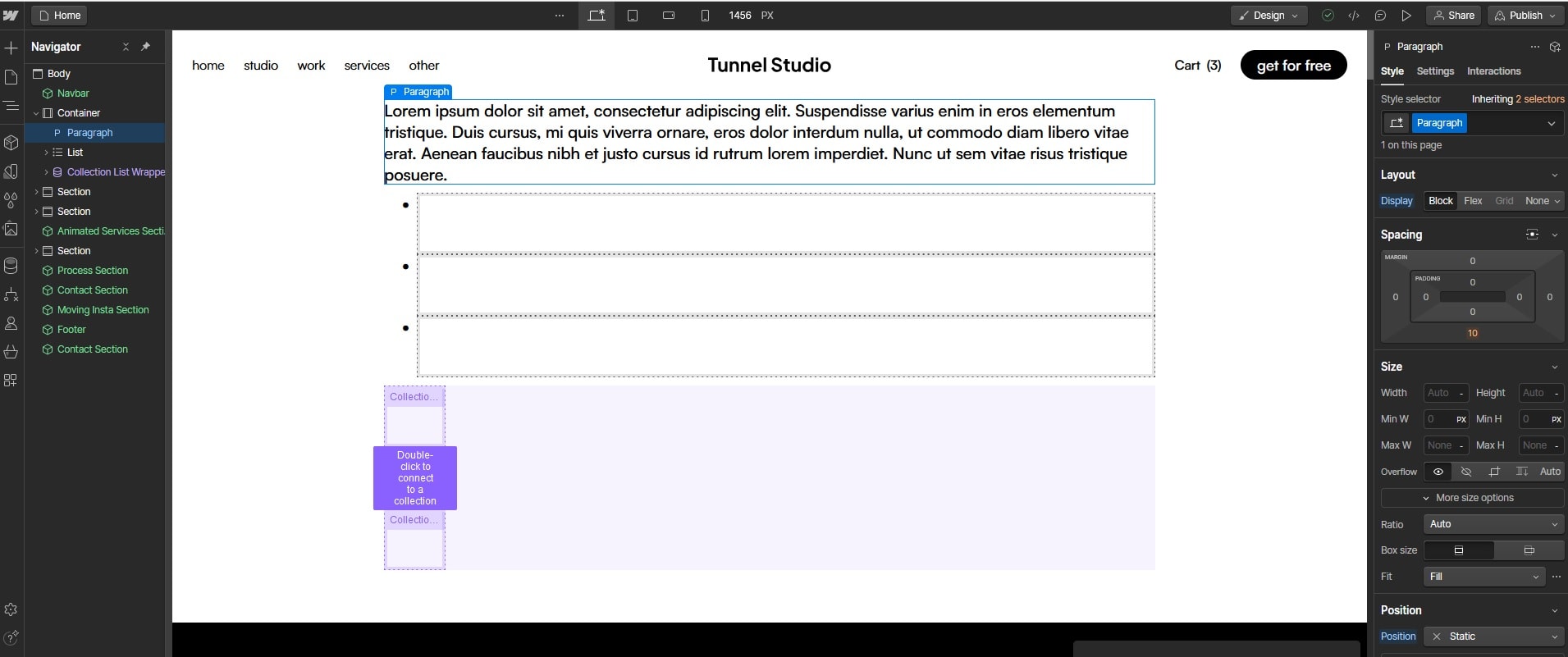
Webflow
Webflow combines visual design features with visual coding features. The dashboard includes links to apps, integrations, design templates, and layout libraries. Webflow's Designer tool provides features for designing site look and feel, adding content, managing users, inserting animations, and customizing code.
Webflow stands out for its headless content management system (CMS). In traditional CMS systems, site front-end design and content presentation ("head") bundle with backend coding. This means any coding changes directly change site appearance, and appearance changes require coding adjustments. You have to customize code to render sites on different devices, platforms, and apps.
A headless approach decouples front-end site appearance from back-end coding and content management. A headless CMS platform delivers content from the backend to the front end through a script connecting software apps. Called an application programming interface (API), this script lets developers separately manage coding, content, design, and integration with other apps.
A headless CMS helps developers deliver content to multiple apps, platforms, and devices without coding changes. APIs handle integrations between content management and presentation. Coding remains stable whether users consume your content on an Apple, Android, desktop, browser, or app. Developers can flexibly adapt the design to support multiple audiences.
This approach makes editing in Webflow different from editing in many CMS platforms. Webflow uses sidebars to control HTML, CSS, and JavaScript coding for elements such as containers, layouts, typography, and user-triggered animations. You can drag and drop components onto your page and then edit their coding properties.
Direct coding control gives you more design flexibility than platforms that rely on drag-and-drop editing to edit code indirectly. However, you need some understanding of coding to edit efficiently. Fortunately, the sidebar menu options and Webflow's help tools make it easy to adjust elements with minimal coding knowledge.
Additionally, you can adapt your design to different devices, platforms, and apps independently of back-end coding changes. However, your ability to preview how your site looks in different environments can be limited. Webflow mitigates this by providing responsive design preview tools. But for best results, you'll want to check your site on actual devices rather than just in a browser.
Squarespace features

Squarespace
Squarespace lets you build sites visually by using templates and drag-and-drop editing. You select a template and then edit it using drag-and-drop to add elements such as text and images. You can adjust element properties such as fonts through drop-down menus. Through templates, drag-and-drop, menus, and other visual tools, you edit code indirectly rather than working with it directly.
Squarespace does allow you to add and edit custom code. However, the interface subordinates this option to the drag-and-drop default.
This approach promotes ease of use, allowing webmasters without coding experience to build websites. However, it limits your options for design and functionality unless you can code or hire a website developer.
Additionally, you define how your site will look on different devices, platforms, and apps as you build it. This contrasts with the headless approach that lets you address site rendering independently of coding and content management. However, Squarespace mitigates this issue by building responsive design into its sites.
4. SEO capabilities
Webflow and Squarespace both provide essential SEO features to boost your online presence. Webflow requires more customization to manage SEO, while Squarespace provides built-in SEO tools with limited custom extension options.
Webflow SEO capabilities
Here are Webflow’s SEO features:
Global SEO Settings: Webflow's dashboard allows adjustments to global SEO settings, including options for robots.txt, sitemaps (auto-generated or custom), and setting canonical URLs. Custom domains unlock these advanced settings, and you can verify your site with Google Search Console.
Page-Specific SEO Settings: Each page can be optimized with custom titles, meta descriptions, and Open Graph settings, allowing you to control how pages appear in search results and on social media.
Advanced SEO Features: Webflow supports custom markup, 301 redirects, and image alt tags, while its fast-loading pages contribute to better search rankings.
CMS-Specific Features: CMS collection pages let you define SEO templates for blog titles and descriptions, offering flexibility for content-heavy sites.
Squarespace SEO capabilities
Squarespace includes built-in SEO features, including:
Built-in SEO Tools: Squarespace includes features like custom page titles, meta descriptions, auto-generated sitemaps, clean URLs, mobile optimization, and SSL certificates for better security and rankings.
Ecommerce and Multilingual SEO: Ecommerce sites benefit from static URLs for categories, and SEO-friendly translations make it easier to target international audiences.
AI-Generated SEO: Squarespace provides AI tools to create SEO-friendly copy for blogs, product descriptions, and more.
Google Search Console Integration: Integration with Google Search Console makes it easy to monitor site indexing and performance.
SEO Panel: A dedicated dashboard simplifies optimization for users, making Squarespace an accessible choice for non-technical users.
Squarespace offers limited extensions for extra SEO functionality and advanced features. But more custom extensions are available from third parties.
5. Mobile responsiveness
Both Webflow and Squarespace provide mobile-responsive features. Webflow allows you to customize responsive style adjustments for different screen sizes. Squarespace includes built-in responsive design features.
Webflow mobile responsiveness
Find a Webflow Website Developer for Hire
Webflow includes several key features to support responsive web design. Webflow's Designer canvas lets you see how reflowing content adjusts to the browser viewport width. For example, you can see how a paragraph wraps content based on browser width. Based on what you see, you have different options for making adjustments.
Webflow lets you use relative sizing to adapt image dimensions to browser width or page parent objects. This ensures that images don't get stuck at fixed sizes that are poorly suited for different screen dimensions.
Webflow uses a feature called breakpoints (media queries) to allow customization for different screen sizes. Breakpoints represent dimensional checkpoints that distinguish how sites appear at different screen sizes. You can use breakpoints to preview different sizes and see what needs adjustment at various dimensions.
By default, Webflow includes breakpoints for desktop, tablet, mobile landscape, and mobile portrait. You can add larger breakpoints for 1280px, 1440px, and 1920px. Changes for desktops automatically cascade upwards to larger sizes and downward to smaller ones. Similarly, tablet adjustments cascade down to mobile. However, you can override automatic adjustments for specific sizes.
Squarespace mobile responsiveness
Squarespace uses built-in features to manage responsive design. A device view feature lets you preview how your site appears on mobile screens. Newer versions of Squarespace let you rearrange content for mobile and desktop viewing separately. The classic Squarespace editor stacks content vertically for mobile viewing.
For images, Squarespace stores up to seven versions of each image you upload, ranging from 100 pixels to 2500 pixels in width. Squarespace's built-in responsive design automatically serves the correct image width based on the viewer's screen size. Squarespace provides image and text best practice recommendations to support responsive design.
Find a Squarespace Website Developer for Hire
6. Templates and themes
Webflow and Squarespace both offer hundreds of template options. Most Webflow templates are premium, while most Squarespace templates are free.
Webflow templates and themes
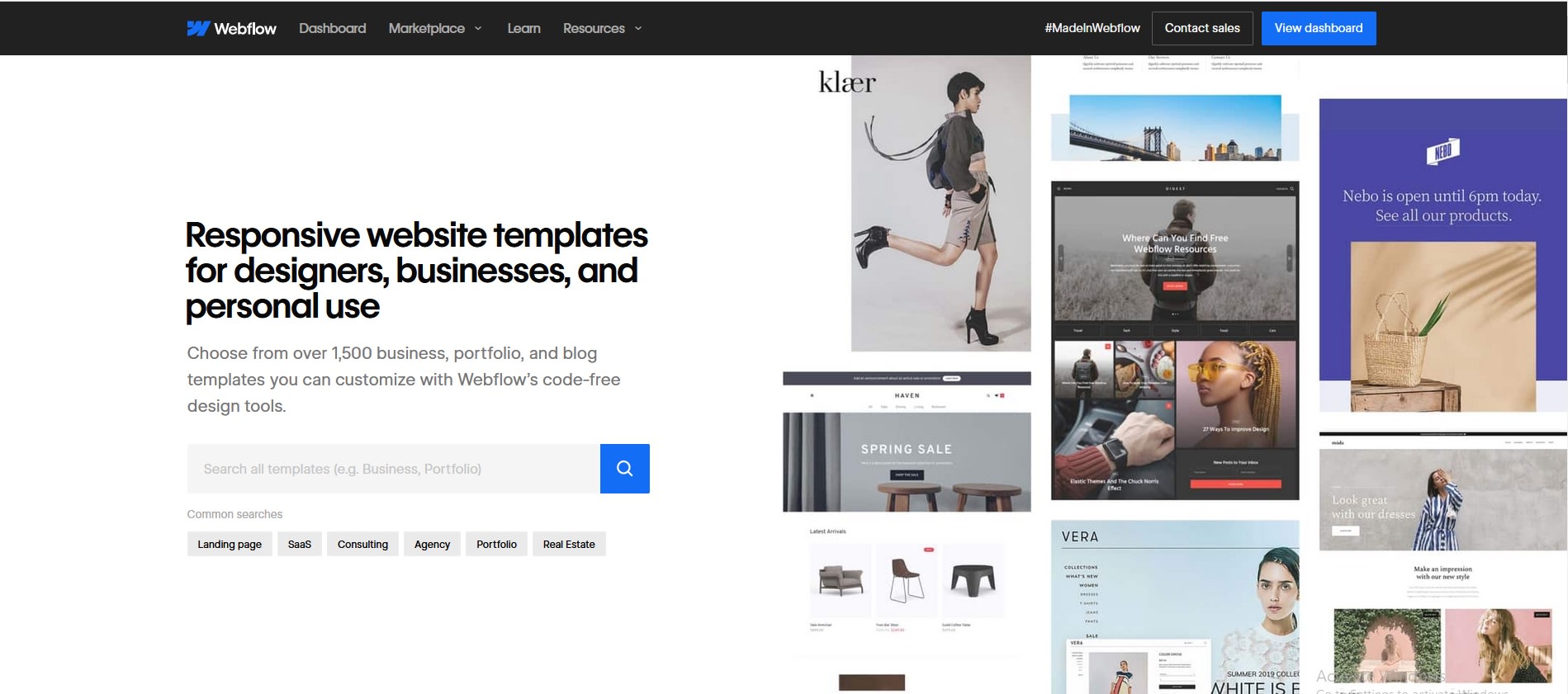
Webflow
Webflow offers over 1,500 templates. Most are premium, but about 73 are free. Template styles are grouped into a few major types, including:
Agency
Blog
Designer
One page
Photography
Portfolio
Multi-layout
Startup
Restaurant
Real estate
Webflow offers templates for several industries, including:
Photography and video
Blogging
Marketing
Travel
Technology
Sports
Nonprofit
Medical
Food and drink
Fashion
Entertainment
Education
Design
Beauty and wellness
Business
Expert template creators supply Webflow with curated templates.
Squarespace templates and themes

Squarespace
Currently, Squarespace offers 180 templates grouped by type and industry topic. Most are free. Types include:
Online store
One page
Blog
Portfolio
Services
Scheduling
Memberships
Courses
Topics cover a broad range of industries:
Art and design
Community and nonprofits
Entertainment
Events
Fashion
Fitness
Food
Health and beauty
Home and decor
Local business
Media and podcasts
Nature and animals
Personal and CV
Photography
Professional services
Real estate and properties
Restaurants
Travel
Weddings
Squarespace offers collaborative design templates created by brands and photography professionals. You can bookmark your favorite designs.
Squarespace provides a Blueprint AI tool to help you build your site. You can build using:
Blocks: Allow drag-and-drop editing of text, images, buttons, and forms
Sections: Organize blocks into rows, columns, slideshows, and carousels
Layouts: Group sections of blocks into pages
Squarespace allows you to use prebuilt blocks, sections, and layouts. You can customize current components or build your own.
7. Customer support
Webflow and Squarespace both provide extensive customer support. Support features for both platforms include automated assistance, self-help tools, and access to customer service.
Webflow customer support
Webflow provides a range of support options for both new and experienced users. The onboarding process includes a site-building wizard, pre-designed templates, and tutorials to help users get started. A site-building checklist and in-app prompts offer additional guidance throughout the process.
For ongoing help, Webflow’s navigation menus include links to a search bar, guides, courses, a community forum, and a help request system. The Webflow support portal also offers customer service, access to Webflow University’s documentation, and development support tools to address user needs.
Squarespace customer support
Squarespace offers helpful support from the very beginning of the web development process. An onboarding wizard and optional AI assistant guide new users through setting up their websites. The dashboard includes a setup guide link and direct access to the help center for quick assistance. Customers also benefit from 24/7 support for any questions or issues.
Squarespace takes care of platform updates and site backups automatically, giving users one less thing to worry about. A status tool is available to monitor maintenance and keep you informed about platform performance.
8. Ecommerce capability
Both Webflow and Squarespace offer strong ecommerce functionality, but they cater to different types of users. Here’s how their features compare:
Webflow ecommerce capability
Webflow provides built-in ecommerce tools and flexibility for advanced integrations. The ecommerce menu in the site sidebar allows users to manage products, categories, discounts, orders, and subscriptions. With Webflow's CMS, you can organize inventory, including digital assets, and create a seamless shopping experience with features like shopping carts and email marketing.
For users who need more advanced ecommerce options, Webflow's coding capabilities allow integration with platforms like Shopify. This combination leverages Webflow’s headless CMS for content management alongside the ecommerce power of third-party tools.
Squarespace ecommerce capability
Squarespace offers straightforward ecommerce features across its pricing plans. Free invoicing is included with all plans, while transaction fees (3%) apply to Business users but are waived for higher-tier plans.
The Business plan includes basic sales and checkout tools, while the Basic Commerce plan introduces features like related product recommendations, waitlists, and low-stock alerts to encourage purchases. Advanced Commerce users gain access to tools like free shipping for specific orders, location-based shipping rates, advanced discounts, and subscription options for members.
9. AI-powered tools
Both Webflow and Squarespace use AI web building aids to support users, but in different ways. Here’s how.
Webflow AI-powered tools
Webflow provides a variety of AI tools to support users. An AI assistant helps users answer support questions. An AI analytics assistant supports Webflow customers who use Intellimize, a personalization and optimization AI tool owned by Webflow. AI-powered translation assists users with localization marketing. Webflow integrates with third-party AI apps like Fluid SEO.
Squarespace AI-powered tools
Squarespace offers new customers the option of using an AI assistant to select their site's template. Optional AI prompts help users generate and edit text content for blogs, emails, and product and video descriptions.
And the winner is… Webflow
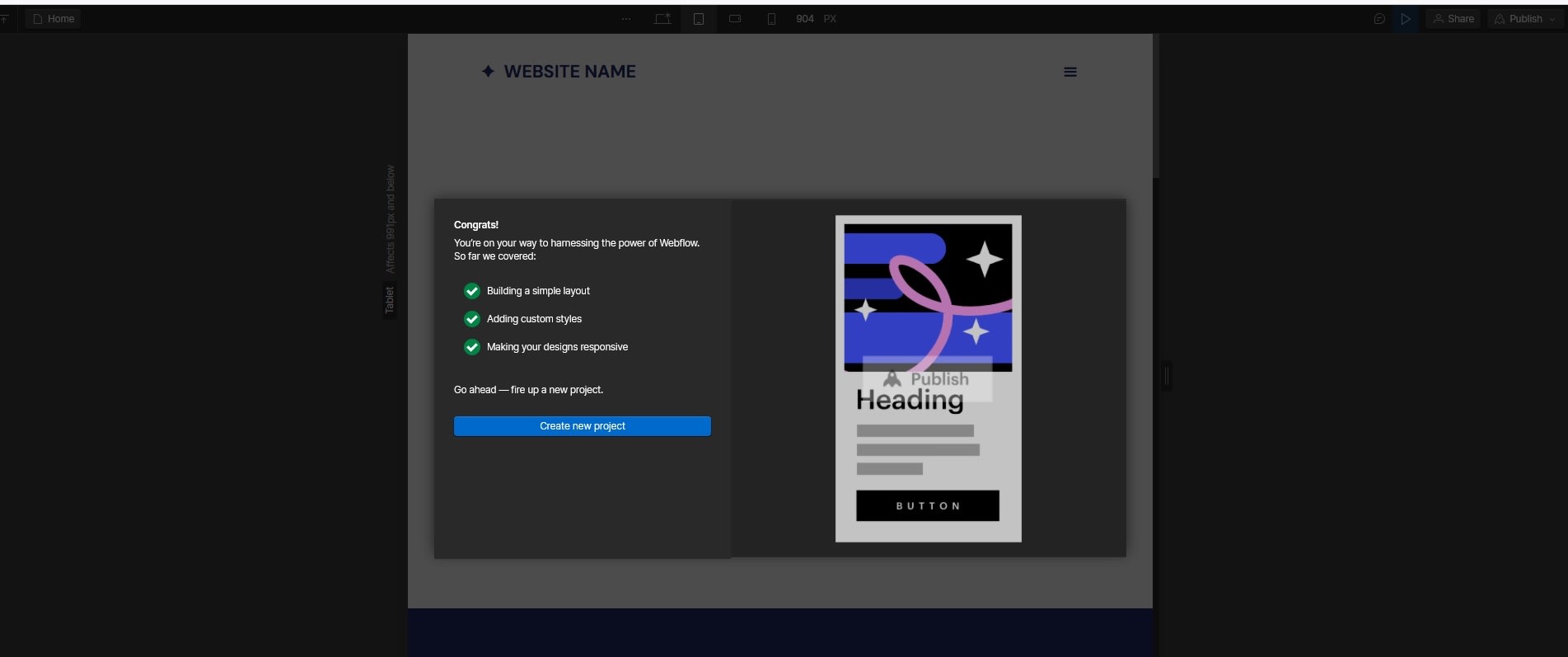
Webflow
Overall, if you're comfortable with coding, Webflow wins over Squarespace in terms of design flexibility and functional adaptability. You can create any design you envision and build any functionality you need. You can modify web templates without hiring a developer. If you're a freelance web designer, a marketing agency, or a startup, this may make Webflow a good choice.
On the other hand, if you're more concerned with ease of use than flexibility, Squarespace may be a better choice for you. Squarespace best fits web design beginners, entrepreneurs, and small business owners who need user-friendly website design tools.
Hire a professional website developer from Fiverr to create your website
Whether your team has coding experience, you may prefer to hire a professional website developer to create your Webflow or Squarespace site. You may not have time to master the learning curve for these platforms. Or you may want to save time to focus on other aspects of growing your business.
If you need help building your site, Fiverr's platform makes it easy to hire experienced Webflow development and Squarespace development professionals. You also can find help with site-building tasks, like content writing and graphic design. In Fiverr, you can also search based on what services you require, experience, turnaround time, and budget.
Webflow vs. Squarespace FAQs
1. Is Webflow better than Squarespace?
Webflow is better than Squarespace for coding flexibility, but not for ease of use by new web developers uncomfortable with code.
2. What is the downside of using Webflow?
Webflow has a longer learning curve if you don't know code.
3. Is Webflow still relevant?
Yes, Webflow powers 1.1% of all CMS sites and 0.8% of all websites, positioning it competitively against Squarespace. Despite trailing other CMS platforms in the number of users, it leads in percentage of high-traffic sites.
4. Is Webflow used by professionals?
Yes, Webflow clients include major corporations such as Philips, Dropbox, and The New York Times.
5. How much does it cost to hire a developer to help with website design?
If you're wondering what kind of budget you'll need to hire a developer, we've put together a guide on website design costs.
